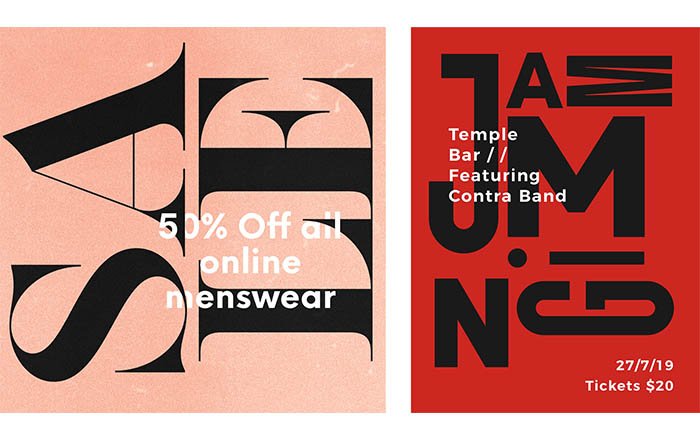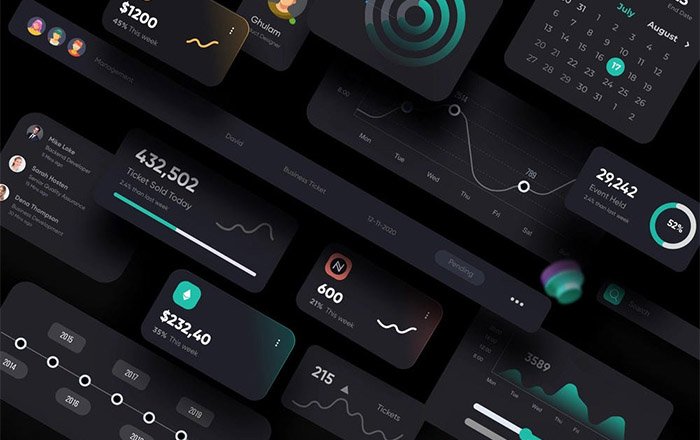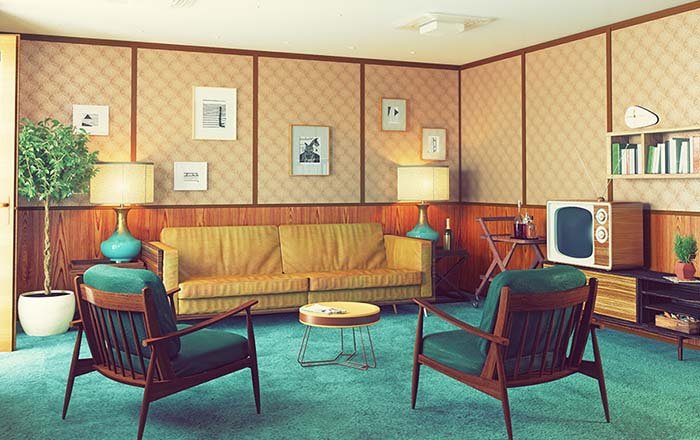Predicted Design Trends for 2023: 7 Styles to Keep Your Eye On

As designers, it is essential to stay up to date on the latest design trends. Keeping an eye out for emerging styles and incorporating predictions into designs can help businesses create projects that are both visually pleasing as well as practical solutions which will give them a competitive edge in their respective industries.
Below outlines seven of the predicted design trends of 2023. These upcoming developments promise diverse impacts across sectors including fashion, technology, and travel; with teams being able to explore sustainability measures whilst integrating minimalism principles or introducing retro/vintage touches enhanced by unique gradients -allowing users to experience enveloping brand stories tailored specifically towards modern sensibilities & preferences ever seen before now.
Trend 1: Organic Shapes

Organic shapes are becoming increasingly popular in design as they add interest and visual impact to projects.
By embracing organic elements like curves, lines, or swells, designs feel more welcoming and inviting for viewers compared to standard geometric techniques. Additionally, exceptions made by imperfections within an art piece can help evoke a sense of realism that might not be achieved from rigid forms alone.
Examples of organic shapes in various industries
Organic shapes are increasingly used in design, providing a sense of movement and energy. They can be seen anywhere from: Product packaging to website designs – an eye-catching way to draw attention. Fashion organic forms as it depicts gracefulness while logos utilize them for harmonious looks with curved lines evoking softer aesthetics than sharp angles.
Benefits of using organic shapes in design
Organic shapes make features appear more effortless by blurring the line between man-made structures and nature itself- making it perfect for modern interior works that incorporate natural elements such as plants into their space’s design scheme.
Utilizing organic shapes also helps bring transparency throughout different visual assets so users can have better navigation within any communication platform which leads customers to visualize materials without overwhelming information barraging at once.
Trend 2: Bold Typography

Typography is a crucial element in the design process. It establishes clarity, provides visual hierarchy and structure, directs users through composition paths, and evokes an emotional response from viewers or readers – making it one of the most powerful tools for communication in all types of media.
Its purpose is to ensure that copy isn’t simply presented as ‘words on a page’. Using bold typographic elements highlights important words or phrases for emphasis – often used by designers as primary branding focal points within graphic compositions
Examples of bold typography in various industries
Ranging from logos and advertisements to website designs- bold typefaces can be used as a focal point, while fonts with thinner strokes can provide both visual appeal and readability.
Benefits of using bold typography in design
Benefits of using bold typography include improved legibility on smaller screens, better attention-grabbing capabilities for ads or headlines, and easier navigation through text-heavy pages such as online stores or blogs. With proper implementation of colour palettes and leading measures, this design trend is sure to help businesses stand out within the industry.
Trend 3: Dark Mode

The dark mode is a design style characterized by mainly dark colors and minimal use of light. Its popularity has dramatically increased in recent years, as developers strive to improve user experience on both desktop devices and mobile apps with improved visibility settings that reduce strain on users’ eyesight, especially at night or low-light conditions.
Specifically for interfaces, dark modes can provide greater contrast which contributes towards UI accessibility thus making them more accessible for people with color blindness or vision impairments.
Benefits of using dark mode in design
Dark mode has become increasingly popular in design, providing a striking contrast between light and dark elements of the user interface. Examples of dark mode can be seen in software such as macOS Mojave or websites like Twitter or Netflix.
Dark Mode is beneficial for eye health by reducing strain on the eyes due to its limited use of bright colors compared to traditional interfaces which may cause overstimulation; this makes it especially suitable for efficient nighttime reading and longer periods at one tasking tasks/activities. Additionally, because darker color schemes tend to require fewer resources than lighter ones- overall making better utilization out of batteries and other power sources -it’s an ideal choice when attempting to conserve energy systems.
Trend 4: Sustainability

Sustainability is an increasing trend in design, as people become more aware of environmental and social impacts.
This shift towards sustainable practices can be seen everywhere from renewable materials to eco-friendly packaging designs. Special attention is being placed on the impact that businesses have on both their local community and the environment at large with a demand for ethical production processes, waste reduction strategies, and recycled materials used in creations.
Examples of sustainable design in various industries
Sustainability is becoming increasingly important in all aspects of design. Examples can be seen across a wide range of industries, such as:
- Fashion and textiles using organic materials with low environmental impact
- Web and UI/UX design prioritizing energy efficiency or single-use digital products
- Architecture incorporating renewable energy sources like solar panels, green roofs
- Product mass production leveraging recyclables instead of depleting finite resources—the list goes on.
As consumers become more conscious about the effects their purchases have on their environment they will expect designers to reflect these values in concepts that prioritize sustainability above all else.
Benefits of using sustainable design practices
Using sustainable design practices offers many benefits, both environmentally and economically. The sustainable design uses renewable materials which reduces emissions creating a more eco-friendly production cycle.
It helps reduce waste by encouraging the use of recycled items where possible as well as repurposing existing objects instead of replacing them with something new, helping to save money in the long run. Additionally, investing heavily in sustainability increases customer trust while driving brand loyalty making it an invaluable practice for any business or industry looking to succeed in today’s market landscape.
Trend 5: Minimalism

Minimalism is a design style characterized by its simple, uncluttered look that uses negative space to create an airy feel. This trend eliminates distractions and allows the focus of viewers to be placed on certain elements such as typography or white space. It also leaves room for added creativity in website designs since there are fewer distracting visuals.
Minimalist design can bring about elegance and sophistication which makes it great for industries like fashion, luxury retail, high-end technology, etc., who want their products/products displayed with finesse without sacrificing quality or attention-grabbing factor.
Examples of minimalist design in various industries
The trend has been seen across various industries such as fashion, home decor, web design, and product development.
In terms of architecture, modern minimalistic designs emphasize clean lines with simple shapes and forms to create an aesthetically pleasing space without excess decoration or ornamentation.
Minimalist interior styling often uses neutral colors combined with one or two bold color accents which can provide a calming atmosphere yet still make memorable statements in the environment it inhabits.
Additionally, products from tech giants like Apple also embrace minimalist principles by using sleek materials models to produce functional objects that keep what’s important at their core while maintaining maximum efficiency levels throughout use cases.
Benefits of using minimalism in design
Brings an air of sophistication and elegance to designs, while still being memorable. By using a minimalistic approach, designers are able to create beautiful visuals that are easy on the eyes without overwhelming viewers with too many elements or colors.
It also increases readability by allowing for more white space between text lines and images; this makes it easier for people to understand complex subjects quickly and efficiently.
This minimalist look can be used across various industries such as fashion, web design, and branding identity creation – anywhere where aesthetics play an important role in marketing materials.
Trend 6: Gradient Design
Gradients are a great way to create depth and visual interest. They can be subtle or vibrant, depending on the effect desired. Gradients add dimensionality that flat designs often lack while remaining modern and eye-catching.
Essentially they provide an in-between from solid colors but with monochrome tones swapped out for multiple shades which blend seamlessly into one another creating unique compositions. Designs utilizing gradients look sophisticated yet contemporary allowing you to make bold statements without detracting away from other elements within your design composition
Examples of gradient design in various industries
Gradients are becoming increasingly popular in design — from digital interfaces to print publications. Gradient effects can be used for many things, including creating an eye-catching background or highlighting certain parts of a user interface element.
For example, gradients might feature prominently on interactive website buttons and menu item backgrounds as well as product logos and packaging designs for consumer items like clothing or tech devices. Businesses across industries—such as retail stores expanding their online presence with visually striking e-commerce sites—are beginning to experiment more with gradient use within their branding materials too.
Benefits of using gradients in design
Using gradients in design helps create beautiful, eye-catching visuals with just a few simple elements.
Add soft interest and subtle depth while still remaining minimalistic; they are also highly customizable and versatile enough to match any style or theme desired.
Allow designers more freedom of experimentation when creating dynamic backgrounds, text effects, gradient logos, buttons, etc., making them useful for all types of visual media from websites to app interfaces.
Using gradients adds an element that flat colors lack–dynamic movement—allowing you the opportunity to make creative-looking pieces without distraction.
Trend 7: Retro and Vintage

Retro and vintage design has seen a resurgence in popular culture, as consumers have started to show an appreciation for nostalgia.
It can be seen everywhere from clothing lines to television shows or packaged products with classic logos. Designers strive to incorporate the charm of retro designs while giving them modern updates with minimalistic elements that are relevant today.
Retro style brings together traditional shapes & materials used long ago but presented within new contexts and updated color palettes making it relatable yet distinctively nostalgic which is so attractive nowadays.
Examples of retro and vintage design in various industries
The retro and vintage design has made a resurgent comeback over the past few years, offering unique solutions to problems faced by various industries.
Examples of this can be seen in:
- Home décor stores selling furniture pieces with classic lines and sentimental flourishes
- Fashion outlets stocking garments inspired by timeless silhouettes from decades gone-by
- Technology companies readopting retro formats for physical audio devices such as cassettes or vinyl records
Ultimately these styles offer industry players an opportunity to capture old traditions whilst looking towards modern success indicators like consumer intent data across retail budget tiers – evidence that you don’t need cutting-edge features on mass production models if fundamental basics are best executed through simpler but iconic designs.
Benefits of using retro and vintage elements in design
Retro and vintage design elements have the potential to add a unique style, nostalgic sentimentality, and historical significance.
Additionally, it provides designers with playfulness in terms of color palettes that can range from muted pastels all the way through gaudy neons.
There is also an endless opportunity for creative freedom when combining different shapes while playing on classic styles such as Art Deco or Bauhaus; this allows designs to stand out even if they are based on something many people find familiar yet timelessly appealing at the same time.
Conclusion
In conclusion, the predicted design trends for 2023 involve several intriguing styles. Organic shapes help create natural-looking designs; bold typography establishes certainty and cohesiveness in a layout; dark mode brings personality to digital interfaces; sustainability proves its worth by being ecologically responsible yet aesthetically pleasing; minimalism enhances readability and clarity of vision without compromising sophistication or elegance, gradients add dynamism through motionless images; finally, retro elements from past decades have made their comeback.
Staying up-to-date on even just some of these predicted trends is essential for keeping your interface modern while also achieving long-term success amongst other competitors as well as with users themselves
- Contrasting Mobile and Web App Onboarding: Variances, Effective Strategies - September 19, 2023
- 5 Key UX Principles for Enhancing Product Adoption - September 5, 2023
- Flywheel vs. Funnel: Choosing the Ideal Model for Your Business - August 22, 2023


